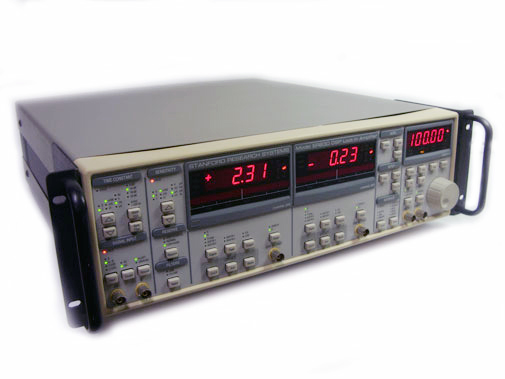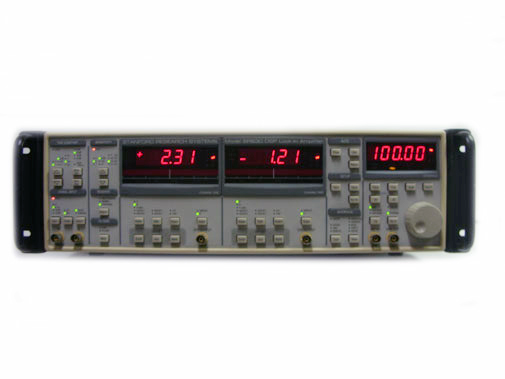본문
|
SR830 |
|||||||||||||||||||
|
Digital Signal Processor (DSP) based lock-in amplifier for the phase-sensitive signal detection. Ensures outstanding signal/noise ratio in measurements of low-level signals.
- 1 mHz to 102 kHz frequency range
- 100 dB dynamic reserve without pre-filtering (<5 ppm stability)
- Time constants from 10 ms to 30 ks
- Harmonic detection (2F, 3F, ..., nF)
- GPIB computer interface
The Stanford Research Systems SR810 and SR830 are part of the SRS family of DSP lock-in amplifiers. Using DSP technology pioneered by SRS, these units deliver unmatched digital performance at a price below that of most conventional lock in amplifiers. While sharing most features and specifications, the SR810 and SR830 differ in a few important respects. In particular, the SR830 has two data displays, allowing the simultaneous display of X and Y, or R and Θ, while the SR810 has only a single data display (although the SR810 allows access to all parameters, including X,Y, R and Θ over the computer interfaces.)
Digital Demodulator
The heart of the SR810 and SR830, is the demodulator, which multiplies the input signal by the reference signal and filters the result. The DSP processor is capable of performing 16 million 24-bit multiplications and additions every second. In the case of the SR810 and SR830 the input is digitised at 256 kHz by a precision 18-bit A/D convertor. It is this digital demodulation technique which is at the root of so many of the SR810 and SR830's performance advantages. The digital technique eliminates the drift, distortion, and aging that are inherent in all analog demodulation designs and allow the SR810 and SR830 to achieve up to 100 dB of dynamic reserve. Dynamic reserve, a key figure of merit for lock-in amplifiers, is a specification often mentioned by lock-in manufacturers without offering a precise definition.
It is always important to keep in mind that many manufacturers do not use this conservative definition of dynamic reserve. The SR810 and SR830 both have up to 100 dB of true available dynamic reserve.
Digital Filtering
The digital signal processor also handles the task of output filtering, time constants from 10 µs to 30,000 s to be selected, with a choice of 6, 12, 18 and even 24 dB/oct filter rolloff. For low frequency measurements (below 200 Hz), synchronous filters can be engaged to notch out multiples of the reference frequency.
Digital Phase Shifting
The clumsy analog phase shifting circuits found in conventional lock-ins have been replaced in the SR810 and SR830 with a precise numerical calculation performed by the DSP processor. This allows phase to be measured with 0.01° resolution and the X and Y outputs to be orthogonal to 0.001°. This represents a significant improvement over analog instruments.
Frequency Synthesiser
The built-in direct digital synthesis (DDS) source generates a very low distortion (-80 dBc) reference signal. Single frequency sinewaves can be generated from 1 mHz to 102 kHz with 4 1/2 digits of frequency resolution. Both frequency and amplitude can be set from the front panel or from a computer.
Easy Operation
The SR830 has two data displays which can be quickly configured to show X, Y, R, Θ, Xnoise, Ynoise or either of the two aux inputs. The SR810 has a single data display. Both the SR810 and SR830 have an additional LED display which can be set to display the reference frequency, phase, or amplitude.
Input Channel
The SR810 and SR830 both have a fully differential input with only 6 nV/√Hz of input noise at 1 kHz and an input impedance of 10 MΩ. The minimum full scale input voltage is 2nV, the lock-ins both include a current input amplifier with a switchable gain of 106 or 108 Volts/Amp. Line (50 Hz or 60 Hz) and 2x line filters are included to reduce line related interference, and the SR810's and SR830's digital architecture eliminate the need for input bandpass filters. Digital design makes it possible to obtain 100 dB of dynamic reserve.
Analog Inputs and Outputs
Both instruments have a user-defined output for measuring X, R, X-noise, Aux1, Aux 2 or the ratio of the input signal to an external voltage. The SR830 has a second user-defined output that measures Y, Θ, Y-noise, Aux 3, Aux 4 or ratio. The SR810 and SR830 both have X and Y analog outputs (rear panel) that are updated at 256 kHz. Four auxiliary 16-bit inputs are provided for general purpose use and can be read from the front panel or the computer interface. Four programmable 16-bit outputs provide voltages from -10.5 V to +10.5 V and can be set via the front panel or computer interfaces.
Internal Memory
The SR810 has an 8,000 point memory buffer for recording the time history of a measurement at rates up to 512 samples/sec. The SR830 has two 16,000 point buffers to simultaneously record two measurements, like R and Θ. Data is transferred from the buffers using the computer interfaces. A trigger input is also provided to externally synchronise data recording.






